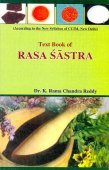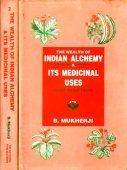Ashtangahridaya, Aṣṭāṅgahṛdaya, Ashtanga-hridaya: 5 definitions
Introduction:
Ashtangahridaya means something in Hinduism, Sanskrit. If you want to know the exact meaning, history, etymology or English translation of this term then check out the descriptions on this page. Add your comment or reference to a book if you want to contribute to this summary article.
The Sanskrit term Aṣṭāṅgahṛdaya can be transliterated into English as Astangahrdaya or Ashtangahridaya, using the IAST transliteration scheme (?).
In Hinduism
Ayurveda (science of life)
Dietetics and Culinary Art (such as household cooking)
Source: Shodhganga: Dietetics and culinary art in ancient and medieval IndiaAṣṭāṅgahṛdaya (अष्टाङ्गहृदय) and Aṣṭāṅgasaṃgraha are considered later treatises as compared to the early Saṃhitas. Vāgbhaṭa, the author of these two texts lived on 5th century CE. The author first wrote Aṣṭāṅgasaṃgraha, [...] The new work is known as Aṣṭāṅgahṛdaya. Aṣṭāṅgahṛdaya is divided into two—pūrvatantra and uttaratantra. In the pūrvatantra there are five divisions which go by the names sūtrasthāna, nidānasthāna, śarīrasthāna, cikitsāsthāna and kalpasthāna.
Unclassified Ayurveda definitions
Source: UiO Faculty of Humanities: Aṣṭāṅgahṛdaya of VāgbhaṭaThe medical manual Aṣṭāṅgahṛdaya by Vāgbhaṭa (ca. 700 CE) is beside the Caraka and Suśruta traditions, one of the three main Indian medical classics. This important text is still in use today, not only in the scholarly medical traditions of India, but also surrounding regions, such as Tibet (Wujastyk 2003). The text gives a comprehensive description of the conception of the human being, his/her illnesses and their cure.

Āyurveda (आयुर्वेद, ayurveda) is a branch of Indian science dealing with medicine, herbalism, taxology, anatomy, surgery, alchemy and related topics. Traditional practice of Āyurveda in ancient India dates back to at least the first millenium BC. Literature is commonly written in Sanskrit using various poetic metres.
Purana and Itihasa (epic history)
Source: archive.org: Puranic EncyclopediaAṣṭāṅgahṛdaya (अष्टाङ्गहृदय).—The medical science which deals in eight separate division the treatment of the human body. (1) Śārīra (2) Bāla (3) Graha (4) Ūrddhvāṅga (5) Śalya (6) Daṃṣṭra (7) Jara and (8) Vṛṣa. Bāla—Body which has not attained maturity; Graha-External elements which damage the health of infants; Śalya—extraneous substance lodged in the body; Vṛṣa-The seminal fluid. (Directions of treatment).

The Purana (पुराण, purāṇas) refers to Sanskrit literature preserving ancient India’s vast cultural history, including historical legends, religious ceremonies, various arts and sciences. The eighteen mahapuranas total over 400,000 shlokas (metrical couplets) and date to at least several centuries BCE.
Languages of India and abroad
Sanskrit dictionary
Source: Cologne Digital Sanskrit Dictionaries: Monier-Williams Sanskrit-English DictionaryAṣṭāṅgahṛdaya (अष्टाङ्गहृदय):—[=aṣṭāṅga-hṛdaya] [from aṣṭāṅga > aṣṭa > aṣṭan] n. Name of a medical work of Vāgbhaṭa
[Sanskrit to German]
Sanskrit, also spelled संस्कृतम् (saṃskṛtam), is an ancient language of India commonly seen as the grandmother of the Indo-European language family (even English!). Closely allied with Prakrit and Pali, Sanskrit is more exhaustive in both grammar and terms and has the most extensive collection of literature in the world, greatly surpassing its sister-languages Greek and Latin.
See also (Relevant definitions)
Partial matches: Hridaya, Ashtanga.
Starts with: Ashtangahridayadipika, Ashtangahridayanamavaiduryakabhashya, Ashtangahridayanighantu, Ashtangahridayasamgraha, Ashtangahridayasamhita, Ashtangahridayoddyota.
Full-text (+52): Cimicima, Khuda, Timirapratishedha, Guhyaroga, Jihvanirlekhana, Vamanakalpa, Cikkira, Chucchundara, Shalyaharanavidhi, Bhutatantra, Darvikara, Ashtangahridayasamhita, Caturthika, Vagbhata, Ashtavidhakushtha, Sarvangasundari, Tinduka, Ashtanga, Grahani, Jatyadighrita.
Relevant text
Search found 18 books and stories containing Ashtangahridaya, Aṣṭāṅgahṛdaya, Ashtanga-hridaya, Astangahrdaya, Aṣṭāṅga-hṛdaya, Astanga-hrdaya; (plurals include: Ashtangahridayas, Aṣṭāṅgahṛdayas, hridayas, Astangahrdayas, hṛdayas, hrdayas). You can also click to the full overview containing English textual excerpts. Below are direct links for the most relevant articles:
Atharvaveda and Charaka Samhita (by Laxmi Maji)
Aṣṭāṅga Hṛdaya (Āyurveda book) < [Chapter 1 - Introduction]
Treatment of Aśmarī (stone disease) < [Chapter 3 - Diseases and Remedial measures (described in Atharvaveda)]
Treatment of Ulcers < [Chapter 3 - Diseases and Remedial measures (described in Atharvaveda)]
Bhesajjakkhandhaka (Chapter on Medicine) (by Hin-tak Sik)
Internal Medicine (e): Gastrointestinal Disturbances < [Chapter 5 - Diseases and Treatments in the Chapter on Medicine]
Seven-day Medicines (a): Lipids and Sweets < [Chapter 4 - Medicinal Substances in the Chapter on Medicine]
(b) Basic Principles of Āyurveda < [Chapter 2 - Background Information]
History of Indian Medicine (and Ayurveda) (by Shree Gulabkunverba Ayurvedic Society)
Chapter 10 - The Pupils of Atreya < [Part 1 - The History of Medicine in India]
Chapter 4 - Text Books of Medicine < [Part 2-3 - Medical Institutions in Ancient India]
Chapter 7 - The Story of Dridhabala < [Part 1 - The History of Medicine in India]
A History of Indian Philosophy Volume 2 (by Surendranath Dasgupta)
Part 18 - Āyurveda Literature < [Chapter XIII - Speculations in the Medical Schools]
Part 11 - The Theory of Rasas and their Chemistry < [Chapter XIII - Speculations in the Medical Schools]
Part 8 - Vāyu, Pitta and Kapha < [Chapter XIII - Speculations in the Medical Schools]
Elephantology and its Ancient Sanskrit Sources (by Geetha N.)
Philosophy of Charaka-samhita (by Asokan. G)
Time and space [in Charaka philosophy] < [Chapter 3 - Fundamental Theories]
The locations, qualities, and the functions of the doṣas < [Chapter 3 - Fundamental Theories]
The theory of three faults (tridoṣa-siddhānta) < [Chapter 3 - Fundamental Theories]
Related products


